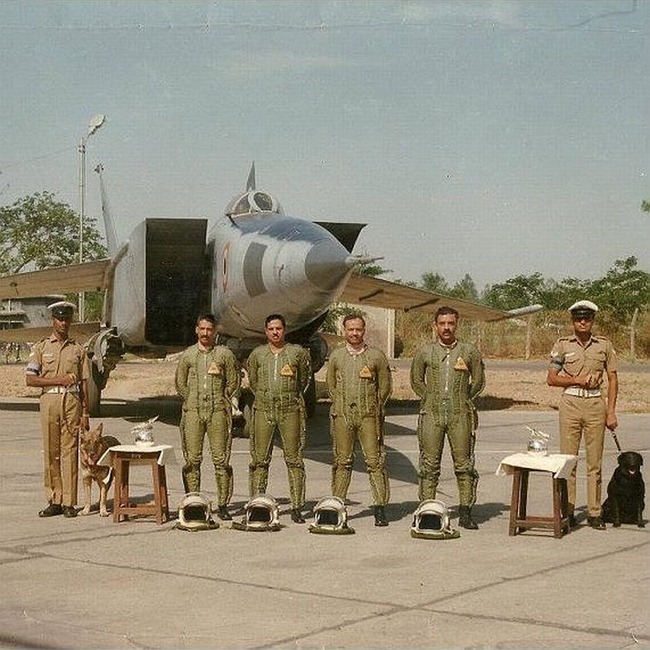A sense of mystique & aura surrounds the Soviet-era MiG-25 fighter aircraft, much like the American SR-71 Blackbird, that saw service with the Indian Air Force [IAF], till 2006. Much of this feeling, I believe, arises knowing that these birds, especially the variants India acquired, were put in to service to carry out reconnaissance activities deep into territories of countries that don't necessarily wave the Indian flag with any sense of deference. The fact that these combat aircrafts were required to fly into enemy territories for reconnaissance even during what constituted as peace time, if needed, at speeds of Mach 3+, at the uppermost reaches of the earth's atmosphere, meant that affairs of these IAF jets were wrapped up in even greater secrecy than a normal highly-guarded IAF asset. Such secretiveness only served to heighten its mystical status.
In fact, a capability quite unique to the the aircraft, its speed & operational altitude, could be put to effective use to send across a forceful message, of a military nature, to belligerent nations, without crossing the rubicon that could trigger or escalate into a state of war. With this as its stated intention, it is being said that, in May 1997, one such MiG-25 aircraft of the Indian Air Force took off from an airbase in India & made a deliberate incursion into Pakistan, intentionally flying deep into its airspace at supersonic speeds, resulting in a Sonic Boom that reverberated across Pakistani territory, including in its capital Islamabad1. The Pakistanis, on the other hand, were singularly incapable of intercepting this intruding fighter in its own airspace, even after the bird made its presence known publically. This act on part of the Indian served to effectively thumb the Pakistanis in their nose, blowing gaping holes into its claim to sovereignty, not unlike the American raid into the Pakistani garrison town of Abbotabad to eliminate Osama Bin-Laden, living not very far from its premier Military Academy, that grooms future generations of Pakistan Army officers.
Indians first got a look into this aircraft, when a team of Indian Air Force Officers were in, then, Soviet Union to evaluate aircrafts that fulfilled Air Staff Requirements [ASR] drawn up by the Indian Air Force. In midst of the evaluation, they were informed of the availability of the MiG-25 for acquisition by India.
"When the team returned to Moscow, the Soviets offered flight evaluation of the Mig-25. at the Krasnodar air base. Air Mshl Katre formed a team consisting of AVM Wollen, Gp Capt Ramu and Wg Cdr Madhav Rao to carry out the evaluation. The team flew down to Krasnodar and Gp Capt Ramu flew two sorties in a Mig-25 U two seat trainer version. He thus became the first IAF plot to fly this legendary aircraft."
- Source
A brief description of the flight by Air Marshal [then, Group Captain] P.M. Ramachandran himself,
"I flew from the front cockpit with Col Uvarov of USSR in the rear cockpit which happens to be the Captain's!! I flew two sorties in Mig 25 UB on 25th Apr 1979 out of Krasnador air base. In the second sortie, I climbed to 26 kms and 2.6 mach. Time from brakes off to cruise at 23 kms / 2.3 M with 2 U turns during climb was 7 mnts 40 secs!I was wearing the same model pressure suit that Yuri Gagarin used!"
- Source
The MiG-25, while being a excellent aircraft, had been designed with the specific purpose of excelling in a given set of roles - as a high speed & altitude interceptor aircraft against incoming American/NATO aircrafts &, later as a reconnaissance platform. To this end, the aircraft was relatively basic & economical that performed its role remarkably well. The American, unable to extract sufficient information about the Foxbats [NATO name for the MiG-25] from behind the Iron Curtain, concluded that the Soviets had, in fact developed a long-range air-superiority fighter with multi-role capability. In response to the conclusion they drew based on what little they knew, the Americans embarked on developing the F-15 fighter, that was designed to best the imagined numerous superlative capabilities of the Foxbat. What came out was an aircraft that is one of the finest multi-role fighters built, but at the same time also highly expensive with a very high development cost. Someone had, quite appropriately, compared the MiG-25 to a Dragster, while the F-15 to a Supercar.
With the advent of Satellites capable to taking high-resolution imageries & Unmanned Aerial Vehicles [UAVs] capable to performing reconnaissance, the need for manned aircrafts to perform the role has been left more or less redundant2. The MiG-25, with all its peculiarities & drawbacks, played a vital role in the security matrix of the country.
Godspeed
Also Read: India-Russia military co-operation
1 - News of a Eurofighter Typhoon going supersonic, creating a Sonic Boom, in a residential area has created an uproar in U.K
2 - Budget cuts has meant that the U.S.A would be unable to acquire the latest surveillance Unmanned Aerial Vehicle like the Global Hawk in sufficient numbers to replace its fleet of of U-2 manned reconnaissance vehicle, that first flew in 1955. Thus they would continue to remain in service, most notably with the troops station in South Korea till at least 2020.
![Air Marshal [then, Group Captain] P.M. Ramachandran, Indian Air Force [IAF], first Indian to Fly Soviet MiG-25 fighter aircraft Air Marshal [then, Group Captain] P.M. Ramachandran, Indian Air Force [IAF], first Indian to Fly Soviet MiG-25 fighter aircraft](http://lh6.ggpht.com/-b2v_HjwcglE/Tyb1oVtWliI/AAAAAAAADzA/pZioqYumKqg/Indian-Air-Force-PM-Ramachandran-MiG-25-02_thumb.jpg?imgmax=800)

![Air Marshal [then, Group Captain] P.M. Ramachandran, Indian Air Force [IAF], first Indian to Fly Soviet MiG-25 fighter aircraft Air Marshal [then, Group Captain] P.M. Ramachandran, Indian Air Force [IAF], first Indian to Fly Soviet MiG-25 fighter aircraft](http://lh6.ggpht.com/-tkfxRja3W8E/Tyb1rsXRZZI/AAAAAAAADzY/xt2rAQaXIug/Indian-Air-Force-PM-Ramachandran-MiG-25-01_thumb.jpg?imgmax=800)
